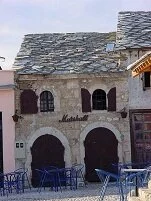Architecture of Bosnia & Herzegovina

Stone Houses in Mostar
The first major architectural style to enter Bosnia & Herzegovina came in the 1400 and 1500s with the Ottoman Turks. The Ottomans introduced Islam to the people and much of the architecture that developed was Mosque architecture similar to the Ottoman style. Later, in the 1800s and 1900s the country was also strongly influenced by the Austria-Hungarians.
During the period under Ottoman rule, the people integrated various styles into the Turkish style creating something that cannot be entirely classified. Many of the building materials used were local as stone work held much sway, while many of the architects in the region were inspired by both the Ottomans and the Renaissance, which was developing in Italy at the time. In addition to these influences, many of the people living in Bosnia & Herzegovina were Croats or Serbs, creating a Catholic and Christian Orthodox influence. Some of the best examples from this time period are in Mostar's old town and Sarajevo, in addition to the Mehmed Pasa Sokolovic Bridge in Visegrad (1570s).